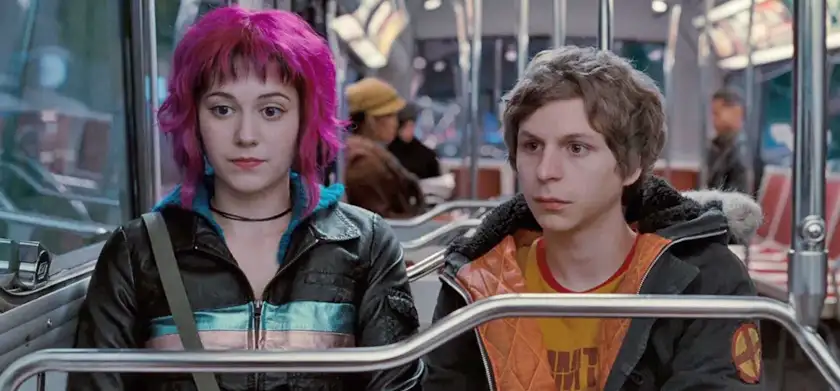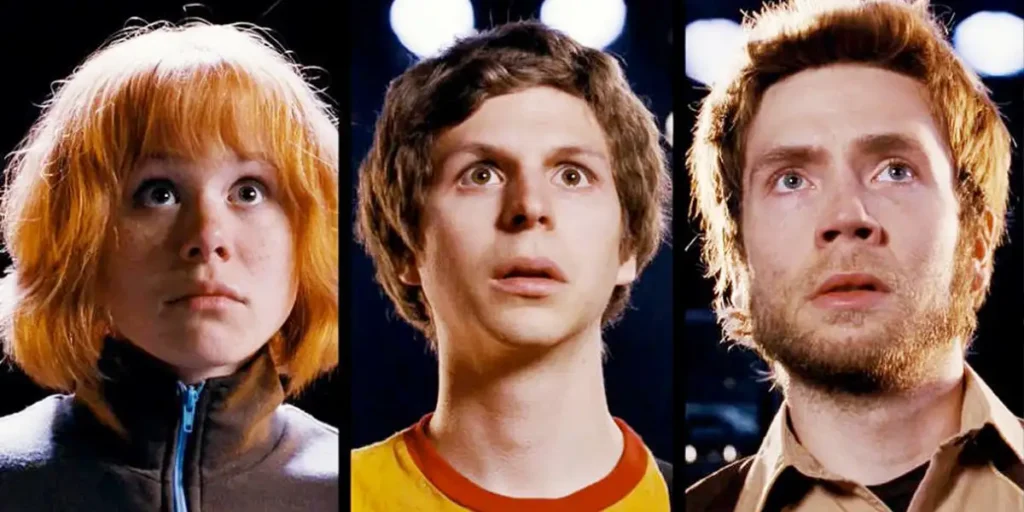Scott Pilgrim vs. The World is Edgar Wright’s most chaotic film, but that does not mean it’s all style and no substance.
Director: Edgar Wright
Genre: Action, Comedy, Fantasy, Teen, Rom-Com
Run Time: 112′
U.S. Release: August 13, 2010
U.K. Release:August 25, 2010
Where to Watch: on digital and on demand
Scott Pilgrim vs. The World (2010) is a film I once described as being “on absolute crack.” With the movie’s fast-paced dialogue, quick-cut editing, and overall vibrant energy, I could be forgiven for simply thinking Edgar Wright’s film was a fun, frantic, mess. Upon repeat viewings, however, I have come to appreciate Wright’s controlled chaos, using a committed cast and a distinct style to comment on growing up, relationships in the 21st century, and learning to accept the lots of life.
In the film, Scott Pilgrim (Michael Cera) is in his early twenties, trying to navigate his budding music career and his revolving-door of relationships. The movie begins with Scott dating a high schooler, Knives (Ellen Wong) but quickly meeting and falling in love with Ramona Flowers (Mary Elizabeth Winstead). Scott quickly realizes that, in order to win Ramona’s affection, he must battle and defeat her “seven evil exes.” The resulting adventure is a mishmash of mid-2000s cultural touchstones (comic books, fighter-style video games, and punk music) that is unlike any other film released during that time, and something we are unlikely to ever see again.
Before diving into what makes this film truly insane, it is important to note how much the cast is on board with Wright’s vision. Cera bounces between calm awkwardness and goofy heroism, while Winstead provides some stability in an otherwise tumultuous roller coaster. Kieran Culkin, Brie Larson, Chris Evans, Aubrey Plaza, Anna Kendrick, and Jason Schwartzman round out the cast, all dialing it up to 11. Each brings a unique sense of humor to the characters. Wright then uses these individual personalities to inhabit an incredibly zestful world.
That zestful world features the “booms!” and “pows!” reminiscent of the 1960s Batman show, hilarious title cards, and a visual flare that is pulled straight out of a comic book or an arcade-style fighting game (Mortal Kombat quickly comes to mind). Each ex Scott faces feels like the next big boss battle, each one increasingly zany and difficult to defeat. These fights are choreographed, colorful, and completely stylized. When the film feels teetering on the edge of becoming slightly redundant, the next battle begins, looking and feeling different than what came before. Wright keeps his audience on their toes at every turn.

With everything that is happening in the filmmaking itself, critics of Scott Pilgrim could easily say the movie is all style and no substance. Even worse, Wright could be accused of mocking his own characters, reducing the serious struggles young adults go through as nothing more than a game we all must play. I don’t think this is the case however. Rather, Wright is drawing on the culture that he knows to empathize with his characters. There are genuine moments of heart on display, especially towards the end, when Scott begins to realize the ways he’s hurt those closest to him. The film seems seriously concerned with questions about how we can escape our past, how we learn from mistakes, and how human relationships can persevere despite the personal challenges each individual has.
Towards the end of the film, Scott receives two “level-ups” as he faces down his final opponent. The first is “love.” Wright centers love as the driving force of human relationships, something that can overcome any obstacle. The second is “self-respect,” a challenge for the audience to accept their own individuality. To say that Wright simply utilizes these visual moments as gags would be to undersell the very real issues the film grapples with. The chaos may seem out of control, but Wright seems to suggest that, much like the real world, chaos can be controlled by the power of our own emotions. One can easily watch the movie and simply be entertained, but for some — especially ones in a certain generation — the film brilliantly blends its wild mise en scéne with themes that will certainly resonate throughout time.
Scott Pilgrim vs. The World is now available to watch on digital and on demand. Read our review of Netflix series Scott Pilgrim Takes Off!

